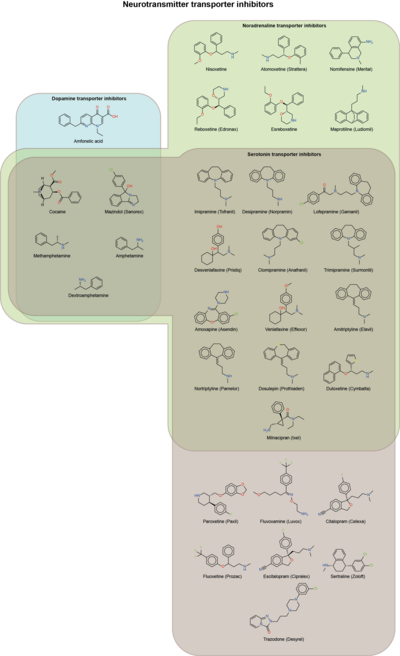Dopamine reuptake inhibitor
| Dopamine reuptake inhibitor | |
|---|---|
attention-deficit hyperactivity disorder, narcolepsy | |
| Biological target | Dopamine transporter |
| Legal status | |
| In Wikidata | |
A dopamine reuptake inhibitor (DRI) is a class of
DRIs are used in the treatment of
Society and culture
History of use
Until the 1950s, dopamine was thought to only contribute to the
Pharmacotherapeutic uses
The following drugs have DRI action and have been or are used clinically specifically for this property:
The following drugs are or have been used clinically and possess only weak DRI action, which may or may not be clinically-relevant: adrafinil, armodafinil, bupropion, mazindol, modafinil, nefazodone, sertraline, and sibutramine.
The following drugs are or have been clinically used but only coincidentally have DRI properties: benzatropine, diphenylpyraline, etybenzatropine, ketamine, nefopam, pethidine (meperidine), and tripelennamine.
The following are a selection of some particularly notably abused DRIs: cocaine, ketamine, MDPV, naphyrone, and phencyclidine (PCP). Amphetamines, including amphetamine, methamphetamine, MDMA, cathinone, methcathinone, mephedrone, and methylone, are all DRIs as well, but are distinct in that they also behave, potentially more potently, as dopamine releasing agents (DRAs) (due to Yerkes–Dodson's law, 'more potently stimulated' may not equal more optimally functionally stimulated). There are very distinct differences in the mode of action between dopamine releasers/substrates & dopamine re-uptake inhibitors; the former are functionally entropy-driven (i.e., relating to hydrophobicity) and the latter are enthalpy-driven (i.e., relating conformational change).[3][4] Reuptake inhibitors such as cocaine induce hyperpolarization of cloned human DAT upon oocytes that are naturally found on neurons, whereas releasing agents induce de-polarization of the neuron membrane.[dubious ][5][6]
The
DRIs have been explored as potential
Monoamine reuptake inhibitors, including DRIs, have shown effectiveness as therapy for excessive food intake and appetite control for obese patients. Though such pharmacotherapy is still available, the majority of stimulant anorectics marketed for this purpose have been withdrawn or discontinued due to adverse side effects such as hypertension, valvulopathy, and drug dependence.[11]
List of DRIs
Only DRIs which are selective for the DAT over the other
Selective dopamine reuptake inhibitors

- α-Pyrrolidinoisohexanophenone (α-PiHP) - very strong and very selective for the dopamine transporter, with little to no effect on the norepinephrine and serotonintransporters
- 4-Hydroxy-1-methyl-4-(4-methylphenyl)-3-piperidyl 4-methylphenyl ketone
- Altropane (O-587)
- Amfonelic acid (WIN 25978)
- Amineptine (has a reasonable degree of selectivity for dopamine over norepinephrine reuptake inhibition)
- BTCP (GK-13), same acronym as for breakthrough cancer pain.
- 3C-PEP
- DBL-583
- Difluoropine (O-620)
- GBR-12783
- GBR-12935
- GBR-13069
- GBR-13098
- GYKI-52895
- Iometopane(β-CIT, RTI-55)
- Ethylphenidate (more selective for DA vs NE reuptake inhibition compared to methylphenidate, but still has a marked effect on both)
- Modafinil (relatively weak but very selective for the dopamine transporter, with little to no effect on the norepinephrine or serotonin transporters)
- Armodafinil (R-enantiomer of modafinil; somewhat more potent at inhibiting DAT than racemic modafinil, with equally negligible action on NET and SERT)
- RTI-229
- Vanoxerine (GBR-12909)
DRIs with substantial activity at other sites
- Adrafinil (weak, possibly stressful on liver)
- Amantadine (also a weak NMDA receptor antagonist)
- Benztropine(also muscarinic antagonist)
- Bupropion (also a more potent NRI and likely NRA due to bupropion's major metabolite hydroxybupropion)
- Cocaine
- Fluorenol (extremely weak)
- Medifoxamine (relatively weak)
- Metaphit (irreversible; depletes dopamine)
- Methylphenidate (has a mild degree of selectivity for dopamine over norepinephrine reuptake inhibition, although it significantly affects both)
- Nomifensine (Dual selective norepinephrine–dopamine reuptake inhibitor (NDRI) is a drug used for the treatment of clinical depression, attention deficit hyperactivity disorder (ADHD), narcolepsy, and the management of Parkinson's disease.
- Phenylpiracetam
- Isopropylphenidate[12]
- Rimcazole
- Venlafaxine (weak)
- Solriamfetol (also norepinephrine reuptake inhibitor)
Other DRIs
- Chaenomeles speciosa (Flowering quince)[13]
- Oroxylin A (found in Oroxylum indicum and Scutellaria baicalensis (Skullcap))[14]
See also
References
- PMID 23045656.
- ^ Jack R. Cooper; Floyd E. Bloom; Robert H. Roth (1996). "9". The Biochemical Basis of Neuropharmacology (7th ed.). Oxford University Press, Inc. p. 293.
- doi:10.1002/chin.200020238.. Page 928 (4th of article) 1st paragraph. Lines 8—11. Mirror hotlink.
- PMID 2141637.
- PMID 23371489.
- PMID 2361170.
- PMID 22363762.
- PMID 22537794.
- S2CID 25378856.
- PMID 16584128.
- PMID 22249822.
- ^ "Isopropylphenidate: An Ester Homolog of Methylphenidate with Sustained and Selective Dopaminergic Activity and Reduced Drug Interaction Liability". Archived from the original on 3 June 2021.
- S2CID 40114711.
- S2CID 23927252.
